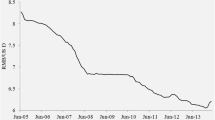Abstract
Whether the Economic and Monetary Union (EMU) satisfies the criteria of an optimum currency area (OCA) has been the subject of much debate. Probably the greatest consensus exists on the trade criterion. In general authors conclude from the high levels of intra-EU trade that the European countries are closely interlinked. In that sense, they would constitute an optimal currency area. In this light, recent empirical evidence that external factors such as exchange rates and oil prices are able to explain inflation differentials between EMU countries is surprising. This paper re-examines the evidence using new and revised data and comes to the opposite conclusion.
Similar content being viewed by others
References
European Central Bank: Inflation differentials in the euro area: potential causes and policy implications, Frankfurt am Main 2003, ECB.
Ibid., p. 6.
S. G. Cecchetti, N. C. Mark, R. J. Sonora: Price index convergence among United States cities, in: International Economic Review, Vol. 43, No. 4, 2002, pp. 1081–1099.
J. H. Rogers: Price level convergence, relative prices and inflation in Europe, Federal Reserve Bank International Finance Discussion No. 699, 2001.
J. M. Berk, J. Swank: Regional price adjustment in a monetary union, the case of EMU, De Nederlandsche Bank MEB series No. 7, 2002.
E. Ortega: Persistent inflation differentials in Europe, Banco de España Working Paper No. 0305, 2003.
E. Alberola; J. M. Marqués: On the relevance and nature of regional inflation differentials: the case of Spain, Banco de Espana Working Paper No. 9913, 1999.
S. C. W. Eijffinger, J. de Haan: European Monetary and Fiscal Policy, Oxford 2000, Oxford University Press, p. 65.
See e.g. I J. M. Arnold, C. Kool: The role of inflation differentials in regional adjustment: evidence from the United States, in: Kredit und Kapital, No. 1, 2004.
See H. W. Sinn, M. Reuter: The Minimum Inflation Rate for Euroland, NBER Working Paper No. 8085, 2001.
For recent reviews see E. Alberola: Interpreting inflation differentials in the euro area, in: Economic Bulletin, Banco de Espana, April 2000; European Central Bank, op. cit. Inflation differentials in the euro area: potential causes and policy implications, Frankfurt am Main 2003, ECB, I. Angeloni, M. Ehrmann: Euro Area Inflation Differentials, mimeo March 2004.
P. Honohan, P. R. Lane: Divergent inflation rates in EMU, in: Economic Policy, Vol. 18, Issue 37, 2003, pp. 357–394, hereafter HL.
European Central Bank, op. cit.
Ibid., p. 29.
For recent surveys see F. Mongelli: “New” views on the optimum currency area theory: what is EMU telling us?, ECB Working Paper No. 138, 2002; and J. Fidrmuc: The Endogeneity of optimum currency area criteria, intraindustry trade and EMU enlargement, Bank of Finland Working Paper No. 8, 2001.
See e.g. textbook treatments of this subject in R. Baldwin, C. Wyplosz: The Economics of European Integration, 2004, McGrawHill; and D. Miles, A. Scott: Macroeconomics: Understanding the Wealth of Nations, New York 2002, Wiley.
See A. Micco, E. Stein, G. Ordoñez: The currency union effect on trade: early evidence from EMU, in: Economic Policy, Vol. 18, Issue 37, pp. 25–64, here Table B1, p. 58.
Ibid. See A. Micco, E. Stein, G. Ordoñez: The currency union effect on trade: early evidence from EMU, in: Economic Policy, Vol. 18, Issue 37, pp. 25–64, here Table B1, p. 58.
G. Peersman, F. Smets: The monetary transmission mechanism in the Euro area: more evidence from VAR analysis, ECB Working Paper No. 91, 2001.
P. J. A. van Els, A. Locarno, J. Morgan, J.-P. Villetelle: Monetary policy transmission in the euro area: What do aggregate and national structural models tell us?, ECB Working Paper No. 95, 2001.
T. Warmedinger: Import Prices and pricing-to-market effects in the euro area, ECB Working Paper No. 299, 2004.
I. Angeloni, B. Mojon, A. K. Kashyap, Daniele Terlizzese: Monetary Transmission in the Euro Area: Where Do We Stand?, ECB Working Paper No. 114, 2002, pp. 9–10.
B. Mojon, G. Peersman: VAR description of the effects of monetary policy in the individual countries of the euro area, ECB Working Paper No. 92, 2001.
P. J. A. van Els, A. Locarno, J. Morgan, J.-P. Villetelle, op. cit. Monetary policy transmission in the euro area: What do aggregate and national structural models tell us?, ECB Working Paper No. 95, 2001.
A. Cunningham, A. G. Haldane: The monetary transmission mechanism in the United Kingdom: pass-through and policy, Central Bank of Chile Working Paper No. 83, 2000.
J. B. Taylor: Low Inflation, Pass-Through, and the Pricing Power of Firms, in: European Economic Review, Vol. 44, No. 7, 2000.
J. Gagnon, J. Ihrig: Monetary Policy and Exchange Rate Passthrough, Federal Reserve Bank International Finance Discussion Paper No. 704, 2001.
The model below closely resembles the model in M. Burda, C. Wyplosz: Macroeconomics: a European Text, 1997, Oxford University Press, p. 383.
P. Bofinger: The Stability and Growth Pact Neglects the Policy Mix between Fiscal and Monetary Policy, in: INTERECONOMICS, Vol. 38, No. 1, pp. 4–7.
European Central Bank, op. cit..
Ibid.. chart 13, p. 29.
Author information
Authors and Affiliations
Rights and permissions
About this article
Cite this article
Arnold, I.J.M., Verhoef, B.A. External causes of Euro zone inflation differentials. Intereconomics 39, 254–263 (2004). https://doi.org/10.1007/BF03031783
Issue Date:
DOI: https://doi.org/10.1007/BF03031783




